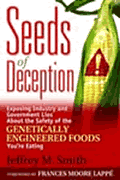Related
Articles:
Cal. County Bans Genetically Modefied Seeds (GMO's)
Hungarians
Protest Agains
GMO Grain
Other
Smith
Articles:
How to Avoid Genetically
Modefied Foods
GENETICALLY ENGINEERED CROPS DAMAGE WILDLIFE
By
Jeffrey Smith
April 10, 2005
NewsWithViews.com
Things aren�t going so well for farmland birds of Western Europe. Some species are at only one tenth their population of 30 years ago and several have abandoned their old habitats altogether. Why? Chemical intensive industrial agriculture is killing the wild seeds and bugs they eat. This trend is particularly alarming in the UK, where about 68 percent of the land is used for agriculture.[1] Dropping bird counts indicate serious environmental imbalance, a trend which the UK Government has committed to reverse by 2020[2] Thus, when the largest environmental study of genetically modified (GM) crops indicated that farmland bird populations would plummet even further if the crops were widely planted, the Independent described it as a nail �hammered into the coffin of the GM food industry,� which, �sealed the fate of GM in the UK.�[3]
The study, released on March 21, 2005[4] was the last of four farm-scale field trials. This one compared GM winter-sown canola (oilseed rape) with non-GM varieties grown side-by-side in 65 plots throughout the UK. For three years, scientists visited fields 7,000 times and counted a million weeds and two million insects. Although the total weed count for the GM and non-GM fields was about the same, the types of weeds were different. GM fields had about one-third fewer seeds from broad-leaved weeds, and that�s the problem for the birds. Skylarks, tree sparrows, bullfinches and others, eat the seeds from these broad-leaved varieties. As the weeds decline, so too would the birds� chances of survival. Also, insects feed on the flowers of broad-leaved weeds. This helps explain why the bee population among the GM fields was cut by up to half and butterflies by up to two-thirds during the month of July.
GM crops don�t directly reduce insect- and bird-friendly weeds. It�s the herbicide that they are engineered to withstand that does the damage. Of the 170 million acres of GM crops planted around the world�almost three times the size of the UK�about 80 percent have their DNA altered to survive applications of herbicide. Farmers spray over the top of �herbicide tolerant� GM crops, a practice that would kill natural varieties. Farmers apply broad-spectrum herbicides to GM crops later in the season and use more of it�lots more. In the U.S., where 64 percent of the world�s GM crops are planted, herbicide use has grown by 138 million pounds over the last nine years. The rate of application is accelerating due to weeds becoming immune to the herbicide. Based on projections from recent trends and reports from land grant universities, the amount of Roundup herbicide used on GM �Roundup Ready� soy (which comprises 85 percent of the US soy harvest) is estimated to be about 86 percent more than that used on non-GM varieties in 2004[5] If the UK trials lasted several more years, the herbicide dosage there would also likely increase and its effects be more pronounced.
Impacts on wildlife vary with the type of GM crop. Two earlier UK farm-scale trials�one looking at spring-sown GM canola, the other GM beets�showed greater damage to butterfly and bee populations and plant diversity than the winter-sown canola. In a fourth trial, wildlife appeared to fair better in the fields of GM corn. But the non-GM fields were treated with atrazine, a weed killer so toxic, it was banned by the EU two weeks after the field trial ended in October, 2003.
Comparing GM crops to a banned substance should have nullified the results of the trial. Nonetheless, the pro-GM UK government approved the corn, but added regulations on how and where the crop could be planted and indicated that the company would assume some liability for crop-related damage. Unwilling to comply with the government�s �obstacles,� Bayer CropScience, withdrew its application for the GM corn three weeks later. Bayer also makes the winter-sown canola that performed poorly in the trial. It turns out that 23 out of 25 EU countries had raised objections to the canola being grown in Europe[6] due to both environmental and health concerns. The Austrian response stated, �No data/studies at all on possible effects on human health are provided.� The French said the safety of the crop �from the health point of view cannot be guaranteed.�[7] Bayer said they wouldn�t even try to grow it in Europe. It is, however, grown in the U.S. and Canada, where studies on health are not required and in-depth environmental impact assessments have not been conducted.
The U.S. government has been sharply criticized for allowing millions of acres of GM crops to be planted without carefully evaluating the consequences. In 1999, after Cornell researchers discovered that pesticide producing GM corn planted around the country may threaten monarch butterflies, a department of agriculture official said, �We knew things like monarchs and other butterflies would be susceptible. That�s part of the general background noise.�[8] Several species of birds in the U.S. are also on the decline, but no studies have been done to see if the increased use of herbicides due to GM crops might be a cause. An article by the U.S. Geological Survey states, �It seems likely, in fact, that more than enough effort is being expended on monitoring birds, and that some of those resources could usefully be redirected to other... work such as identifying causes of declines.�[9]
Large study, narrow focus
The UK farm-scale trials were the largest study ever to evaluate the ecological effects of GM crops. Nonetheless, it overlooked more important data than it gathered.
Contamination of non-GM crops was not analyzed. In Canada, there is so much contamination from GM canola, non-GM and organic farmers have given up and several are filing lawsuits. Many factors are responsible for contamination, including wind and insects. Bees can carry pollen more than 16 miles, yet the current standard separation distance between GM and non-GM varieties in the UK is 50 meters (expandable to 200 in certain cases). Canola also cross-pollinates with weedy relatives such as wild turnip, which become resistant to weed killer. The weeds can harbor the herbicide tolerant gene for years and also transfer it to non-GM canola.
Contamination also occurs when unharvested seeds fall on the ground and then grow in subsequent years. Studies show that if a farmer plants GM canola for one season and non-GM thereafter, his or her harvest will have GM contamination at greater than 1 percent for up to 16 years[10] If the farmer plants a different crop in the same field, the �volunteer� GM canola becomes a difficult weed�resistant to weed killer. In Canada, some plants are resistant to three different herbicides due to cross pollination from multiple varieties[11] Farmers have to use more toxic chemicals to control them.
The UK trials didn�t examine the rising use of herbicides due to GM crops and the impact on the environment or human health. Since the herbicide is sprayed directly on the GM plants, the food carries greater residues. An article published on February 24, 2005 in Environmental Health Perspectives[12] found that glyphosate, the active ingredient in Roundup, had toxic effects and endocrine disturbances on human placental cells in test tubes. The authors believe this might account for reports of increased premature births and miscarriages among women farmers using glyphosate[13] The study also found that Roundup, which contains additional ingredients, was more toxic than glyphosate alone. Similarly, a December 2004 study in Toxicological Science[14] found that Roundup�and not glyphosate alone�damaged the DNA in a way that might increase cancer risk[15]
Another area neglected by the farm-scale trials was analysis of soil ecology. Laboratory studies have confirmed that transgenes from GM crops can transfer into soil bacteria, but the implications of this are not understood.[16]
The trials did not look at the type of GM crops engineered to produce their own pesticide. These �Bt� crops can kill beneficial insects, create pesticide tolerant insects, and put pesticide into the soil, where it can bind with clay and remain stable for months or years.
A more significant area of study that is needed may be the changes to the GM crops� DNA and physiology. The process of genetically altering a crop can damage its DNA, change the output of large numbers of genes, create unpredicted increases or decreases in compounds and nutrients, and cause genetic instability. One controversial study published in Nature[17] found evidence suggesting that the DNA in corn might become unstable after it is cross pollinated with GM varieties. The corn DNA appeared to contain several fragments of the promoter�genetic material inserted into GM crops with the foreign genes. If verified, this finding might mean that the promoter makes the DNA unstable, causing genes to fragment and scatter through the genome. Biotech scientists were quick to argue against such an interpretation, but none have bothered to do follow up research on this potentially disastrous finding.
Finally, the farm-scale trials compared GM crops to the chemical intensive monoculture farming system that was responsible for wildlife devastation. Organic and sustainable farming techniques have been shown to reverse damage to the ecosystem. Shouldn�t some of the millions spent on testing also evaluate these alternatives?
In spite of its shortcomings, the study�s findings about threats to bird populations are significant. According to Frank Gill, the Audubon Society�s former chief ornithologist, �Like the proverbial canary in the coal mine, birds are primary indicators of environmental health, and what hurts birds also hurts the people who share the same space.�[18] The trial also left a lasting impression: The GM traits have certainly spread to non-GM plants, and will persist in the environment perhaps for centuries.
Order Jeffrey M. Smith's book "Seeds of Deception"
Footnotes:
1
www.statistics.gov.uk/.....
2
The state of the UK's birds 2003: The
UK �Quality of Life� wild bird indicator, RSPB
3
Steve Connor, Michael McCarthy and Colin Brown, The end for GM crops:
Final British trial confirms threat to wildlife, The Independent,
22 March 2005
4
David A. Bohan, et al., �Effects on weed and invertebrate abundance
and diversity of herbicide management in genetically modified herbicide-tolerant
winter-sown oilseed rape,� Proc. R. Soc. B (2005) 272, 463�474, doi:10.1098/rspb.2004.3049,
Published online 7 March 2005, [PDF
File]
5
Charles M. Benbrook, Genetically Engineered Crops and Pesticide Use
in the United States: The First Nine Years. BioTech InfoNet, Technical
Paper Number 7, October 2004
6
BIOTECH FIRM REJECTS GM CROP, Press Release, Friends
of the Earth, March, 19, 2005,
7
ibid
8
Carol Kaesuk Yoon, �What�s Next for Biotech Crops? Questions,� New
York Times, December 19, 2000
9
MONITORING THE ABUNDANCE OF BIRD POPULATIONS, U.S. Geological Survey,
Forest and Rangelands Ecosystem Science Center, 970 Lusk Street, Boise,
Idaho 83706, USA, The Auk 122(1):15�25, 2005
10
Squire, G.R. & Askew, A. Final Report - DEFRA project RG0114: The
potential for oilseed rape feral (volunteer) weeds to cause impurities
in later oilseed rape crops. (2003)
11
Orson, J. Gene stacking in herbicide tolerant oilseed rape: lessons
from the North American experience. English Nature Research Report
No. 443. English Nature: Peterborough. (2002)
12
Sophie Richard, et. al., Differential effects of glyphosate and Roundup
on human placental cells and aromatase, Environ Health Perspect doi:10.1289/ehp.7728
available via http://dx.doi.org/
[Online24February2005]
13
Herve Morin, Roundup
Doesn't Poison Only Weeds, Le Monde, 12 March 2005
14
Julie Marc, et. al., Formulated Glyphosate Activates the DNA-Response
Checkpoint of the Cell Cycle Leading to the Prevention of G2/M Transition,
Toxicol. Sci., Dec 2004; 82: 436 - 442.
15
Herve Morin, Roundup
Doesn't Poison Only Weeds, Le Monde, 12 March 2005
16
http://www.i-sis.org.uk/ireaff99.php
17
Quist, D., and I.H. Chapela. Transgenic DNA introgressed into traditional
maize landraces in Oaxaca, Mexico. Nature 414(Nov. 29) 2001:541�543.
18John
Pickrell, Quarter of U.S. Birds in Decline, Says Audubon, National
Geographic News November 5, 2002
� 2004 Jeffrey M. Smith- All Rights Reserved
Sign Up For Free E-Mail Alerts
E-Mails are used strictly for NWVs alerts, not for sale
Jeffrey M. Smith has been involved with genetically modified (GM) foods for nearly a decade. He worked for non-profit and political groups on the issue and in 1998, ran for U.S. Congress to raise public awareness of the health and environmental impacts. To protect children-who are most at risk from the potential health effects of GM foods-Smith proposed legislation to remove the foods from school meals. He also proposed legislation to help protect farmers from cross-pollination by GM crops. Later, he was vice president of marketing for a GMO detection laboratory.
Smith has lectured widely, spoken at conferences, and has been quoted in articles around the world. Prior to working in this field, he was a writer, educator, and public speaker for non-profit groups, advancing the causes of health, environment, and personal development. This book Seeds of Deception, researched and written after he left the industry, combines Smith's passion for these causes with his extensive knowledge of the risks and cover-ups behind genetically modified foods.
Smith is the founding director of the Institute for Responsible Technology, a member of the Sierra Club Genetic Engineering Committee, and a member of the advisory board of the Campaign to Label Genetically Engineered Foods. He has a master's degree in business administration and lives with his wife in Iowa, surrounded by genetically modified corn and soybeans.
Website: www.seedsofdeception.com
E:Mail: info@seedsofdeception.com
Finally, the farm-scale trials compared GM crops to the chemical intensive monoculture farming system that was responsible for wildlife devastation. Organic and sustainable farming techniques have been shown to reverse damage to the ecosystem.









